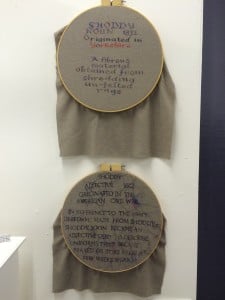Review: Textiles exhibition Shoddy at Leeds’s Live Art Bistro
April 18, 2016

All images credited to Nathan Reaney
Tucked away on a bustling main road, amongst the handful of empty warehouses, furniture shops and a Maplin, lies the compelling building and space belonging to Live Art Bistro. Opening early last year, the space has been key in allowing local artists a habitat for cultivating their skills and craft. Currently holding residence at the venue, is the Shoddy Exhibition, a collective project between nineteen, textiles artists with disabilities in and around Leeds. Their aim is to present a new perspective towards disabilities and the sensitivity surrounding such a topic.
To gain entry to the exhibition, you must first knock on the huge, pink doors of the venue. Here, you are greeted by the curator of the exhibition, Gill Crawshaw. The first thing you notice about the space is its sheer size. The large scale exhibition, takes up only a third of the room, leaving large pockets of emptiness around it. This huge space presents us with ideas of isolation and feelings of insignificance, of which the sensitive subject matter of disability aims to uncover. A variety of material has been used to create the works, ranging from wool, plastic, foil, steel, silk and of course, the exhibitions name sake ‘Shoddy’, a new cloth, created from wooden waste and recycled fabric. By only using recycled materials in the exhibition, the artists represent the change and new life for all of them after they received their diagnosis.

The meaning of the word ‘Shoddy’ is dissected between two embroidery hoops created by Faye Waple. The hoops show the initial meaning of the term referring to the textile industry, rather than the now common associations of being poor quality and inferior. The contrast is highly emotive, and Waple uses these as a jump off point for the social stigmas applied to disability and it being seen as lesser or second-rate.
One of the most captivating pieces is by artist Mow, who evokes feelings of abandonment and waste through her work ‘Not Lost’. Mow’s laundry bag, made out of her own clothes, draws upon her own personal memories and misfortunes of giving everything to the benefit system, and gaining nothing in return. The bag is strewn with old receipts, train tickets, statements and letters. Her piece reflects the poor service and help provided to her by the department of work and pensions, when she needed them the most. The creation of a wash bag specifically, acts as a metaphor for airing dirty laundry in public. Mow refuses to become simply a number in the benefit system she relies on, and feels as though to gain help from a service she needs, she’s forced to let the system deep in to her personal life. The title of her work, references being in the abyss of the system, lost, with no light at the end of the tunnel.

The theme of a callous and unhelpful benefit system continues into the work of others, such as Vickie Orton. Orton has created the piece ‘The Maze of Life’, as an analogy of attempting to find your way through the difficulties of the benefit system. She has created two mazes, each one having a white, woollen base. The first maze is a dark grey labyrinth, felted on top of the white. With the colour grey connoting dark clouds and pathos, it draws upon ideas of dread and hopelessness. The monotony of the grey colour mirrors the government system, and the lack of respect and dignity the system can at times provide. However, Orton counters her first maze with her second. The grey in the latter, is now replaced by a rainbow of colours, each melting in to one another. The colours, though still a maze, don’t show the dead-ends seen in the first. The ease of moving around this maze references the closeness and the support that those in the disabled community provide for each other. The variety of colours could be viewed as strength in numbers between the community, and how they see themselves moving through this maze together.
This exhibition was well needed for putting a spotlight on a subject that the government and society can sometimes ignore. The works show the collective strength, and the fact that the artist’s disabilities do not make up their entire identities. The exhibition allows their voice to be heard, where in the past it may not have been. It’s a voice that deserves to be heard, and treated with the respect that we can all at times take for granted.
To find out more about the project, visit the website.

Comments